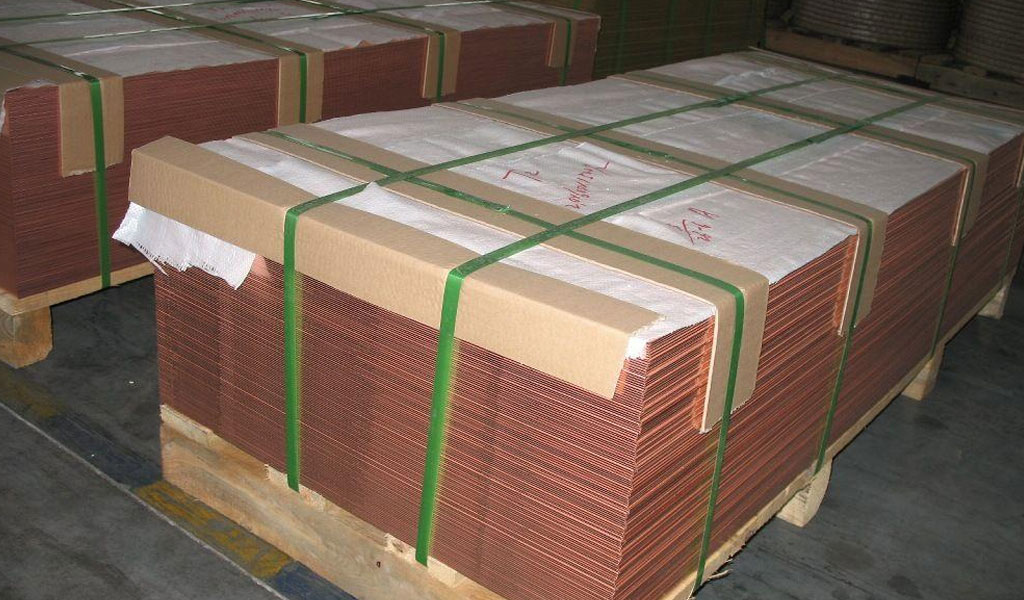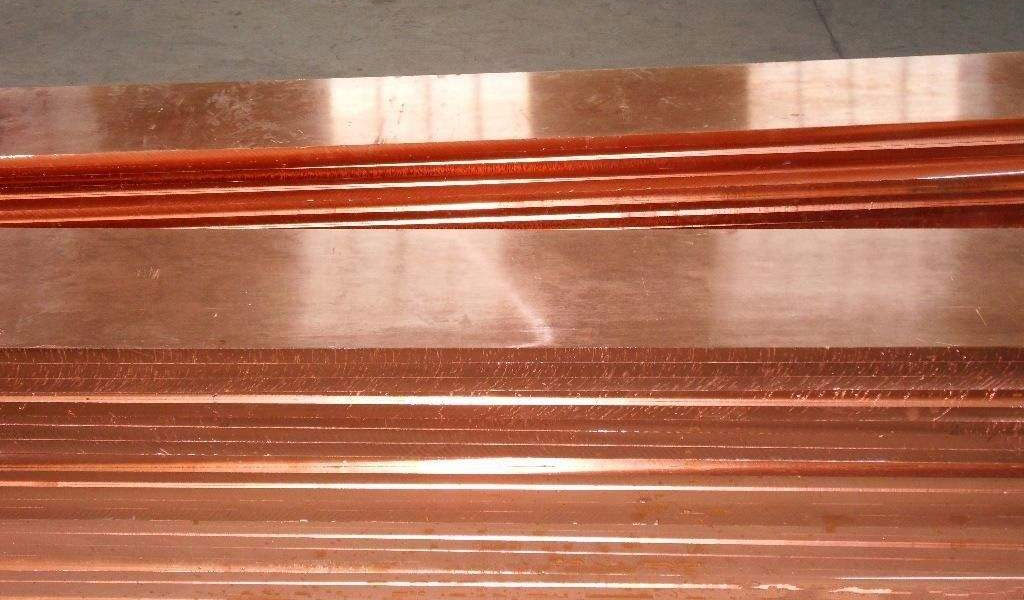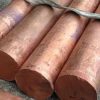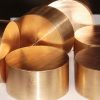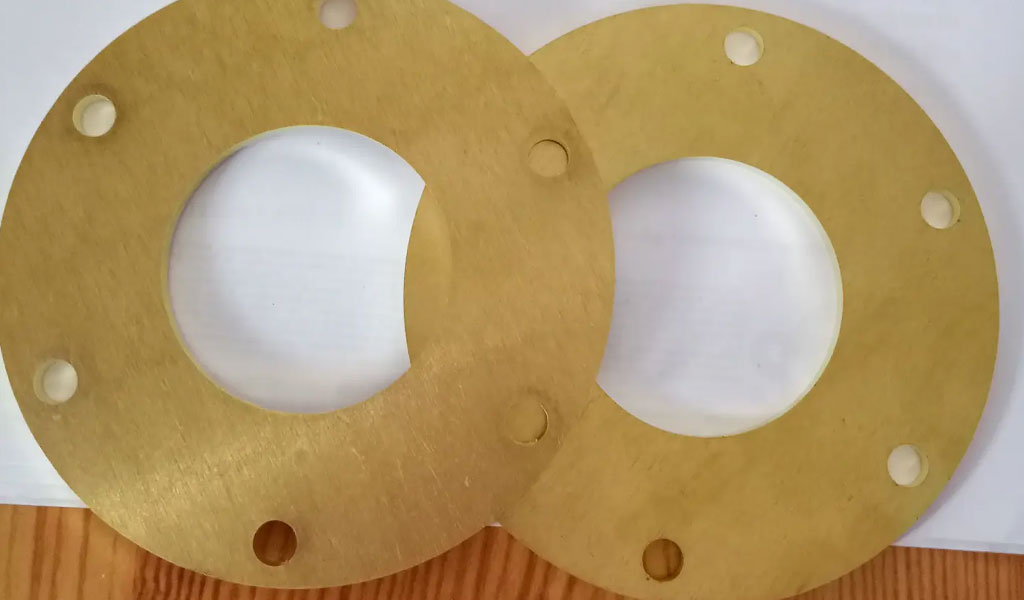
Laser cutting technology has revolutionized manufacturing processes across various industries. When it comes to cutting materials like Beryllium Copper (BeCu), precision and safety are paramount due to the unique properties of this metal alloy. In this comprehensive guide, we’ll delve into the specifics of laser cutting Beryllium Copper, exploring its properties, considerations, safety measures, and applications.
Introduction To Beryllium Copper
Laser cutting is a precise and efficient method used in various industries for shaping and manipulating materials, including metals like Beryllium Copper.
Laser cutting involves using a high-powered laser beam to melt, burn, or vaporize material along a predetermined path, creating precise cuts with minimal waste. The process relies on the concentration of intense light energy to heat and remove material, guided by a computer-controlled cutting path.
Benefits Of Beryllium Copper That Make It Ideal For Laser Cutting
Beryllium Copper (BeCu) possesses several unique characteristics that make it an ideal material for laser cutting in various industrial applications. Understanding these benefits helps underscore why Beryllium Copper stands out as a preferred choice for laser cutting processes:
1. Excellent Thermal Conductivity
Beryllium Copper boasts exceptional thermal conductivity, facilitating efficient dissipation of heat generated during laser cutting. This attribute aids in controlling the heat-affected zone (HAZ), ensuring minimal distortion or damage to the material surrounding the cut area. The ability to manage heat effectively enhances the precision and quality of laser-cut Beryllium Copper parts.
2. High Strength and Hardness
The inherent strength and hardness of Beryllium Copper make it resilient to deformation or warping during the laser cutting process. This durability enables the material to maintain its structural integrity, allowing for precise cuts without compromising the mechanical properties of the finished product. It ensures that intricate designs and fine details can be accurately replicated without any compromise on strength.
3. Superior Machinability
Beryllium Copper exhibits excellent machinability, making it well-suited for laser cutting operations. Its uniform composition and fine grain structure enable consistent and predictable results during cutting, contributing to the production of clean edges and intricate shapes. This characteristic streamlines the laser cutting process, allowing for increased productivity and reduced material wastage.
4. Corrosion Resistance
The corrosion-resistant nature of Beryllium Copper is another advantageous attribute that enhances its suitability for laser cutting applications. This resistance to corrosion ensures that laser-cut Beryllium Copper components maintain their integrity and functionality even in demanding environments. It extends the longevity of the finished products, making them suitable for use in various industries, including aerospace, electronics, and marine applications.
5. Non-Sparking and Non-Magnetic Properties
Beryllium Copper’s non-sparking and non-magnetic properties are crucial in safety-sensitive applications. During laser cutting, the absence of sparks minimizes the risk of fire hazards, making it safer to work with in industrial settings. Additionally, its non-magnetic nature enables its use in applications where magnetic interference could be detrimental, such as in sensitive electronic equipment.
6. Electrical Conductivity
With high electrical conductivity comparable to pure copper, Beryllium Copper is an excellent choice for components requiring electrical connections. Laser-cut Beryllium Copper maintains its conductivity, ensuring the efficient transfer of electrical currents without compromising on the precision of the cut parts.
7. Clean and Precise Cutting
Laser cutting technology, when applied to Beryllium Copper, allows for clean and precise cuts with minimal burrs or imperfections. This capability enables intricate designs and complex patterns to be reproduced accurately, meeting stringent quality requirements in industries where precision is paramount.
The combination of Beryllium Copper’s unique properties—such as excellent thermal conductivity, high strength, corrosion resistance, machinability, non-sparking nature, and electrical conductivity—makes it an ideal material for laser cutting applications. These attributes not only contribute to the ease and efficiency of the cutting process but also ensure the production of high-quality, durable, and precise components across diverse industrial sectors.
Beryllium Copper Grades For Laser Cut
Beryllium Copper, known for its versatility and various applications, comes in different grades that are suitable for laser cutting. The choice of grade often depends on the specific requirements of the intended application. Here are some common grades of Beryllium Copper that are frequently used for laser cutting:
1. C17200 (Alloy 25)
Properties:
- High Strength: Exhibits high tensile strength, making it suitable for applications requiring durability.
- Excellent Conductivity: Maintains good electrical conductivity, ideal for electrical components.
- Good Formability: Offers good formability and machinability, allowing for various fabrication processes.
Applications:
- Electrical Components: Connectors, springs, and switches.
- Industrial Applications: Tooling, molds, and welding equipment.
- Aerospace and Automotive Industries: Springs, bearings, and contacts.
2. C17510 (Alloy 3)
Properties:
- High Hardness: Possesses increased hardness and wear resistance compared to other Beryllium Copper alloys.
- Good Conductivity: Maintains moderate electrical conductivity.
- Excellent Machinability: Offers good machinability and weldability.
Applications:
- Plastic Molding Applications: Core pins, ejector pins, and molds for plastic injection molding.
- Oil and Gas Industry: Non-sparking tools, bushings, and bearings in equipment for explosive environments.
- Electrical and Electronic Industries: Springs and contacts.
3. C17500 (Alloy 10)
Properties:
- High Strength and Toughness: Exhibits good strength and toughness while retaining formability.
- Excellent Conductivity: Maintains high electrical conductivity and thermal conductivity.
- Corrosion Resistance: Offers resistance to corrosion in various environments.
Applications:
- Electrical Connectors: High-performance connectors, terminals, and electronic components.
- Industrial Applications: Springs, bearings, and specialized tools.
- Aerospace and Defense: Bearings, gears, and non-sparking tools.
4. C17410 (Alloy 174)
Properties:
- Increased Hardness: Provides higher hardness and wear resistance compared to other Beryllium Copper grades.
- Good Formability: Offers good formability and machinability.
- Moderate Conductivity: Maintains moderate electrical conductivity.
Applications:
- Machined Parts: Gears, cams, and bearings in industries requiring wear resistance.
- Plastic Molding Industry: Mold inserts and components for injection molds.
- Electrical Contacts: High-performance contacts and connectors.
Considerations for Laser Cutting Various Grades
- Material Thickness: Different grades of Beryllium Copper may have varying thickness capabilities for laser cutting. Thicker materials might require adjustments in laser parameters for optimal cutting results.
- Composition Variations: Each grade may have specific compositions that impact laser cutting parameters. Understanding these variations ensures proper adjustment of laser settings for precise cutting.
- Heat Sensitivity: Despite differences in grades, Beryllium Copper generally remains sensitive to heat. Controlling the heat-affected zone during laser cutting is crucial to maintaining material integrity across all grades.
Selecting the appropriate grade of Beryllium Copper for laser cutting involves considering the specific mechanical, electrical, and thermal properties required for the intended application, while also accommodating the material’s characteristics during the cutting process.
Common Beryllium Copper Laser Cutting Techniques
1. Pulse Cutting
Description: Pulse cutting involves intermittent bursts of laser energy rather than a continuous beam. This technique is useful for precise and delicate cuts, reducing the risk of excessive heat buildup in the material. It helps control the heat-affected zone (HAZ) and minimizes the potential for material distortion.
Advantages:
- Reduces heat exposure, preserving material properties.
- Enhances precision, especially for intricate designs.
2. Burr-Free Cutting
Description: Burr-free cutting aims to eliminate or minimize burrs, ridges, or rough edges commonly formed during laser cutting. By adjusting laser parameters and controlling the cutting speed, power, and focus, this technique ensures cleaner and smoother edges on the cut Beryllium Copper parts.
Advantages:
- Produces high-quality, finished edges without post-processing.
- Reduces the need for additional finishing steps.
3. Contouring and Etching
Description: Contouring involves the precise manipulation of the laser beam to follow intricate patterns or contours on the Beryllium Copper surface. Precision Etching refers to controlled surface ablation, allowing for the creation of detailed designs, logos, or markings on the material.
Advantages:
- Enables customization and branding on Beryllium Copper components.
- Offers flexibility for intricate shapes and patterns.
4. Optimized Parameter Control
Description: This technique involves meticulous adjustment and optimization of laser parameters, including power, cutting speed, and focal length, specifically tailored to the properties of Beryllium Copper. Fine-tuning these parameters ensures optimal cutting quality while minimizing potential material damage or deformation.
Advantages:
- Maintains material integrity while achieving precise cuts.
- Enhances efficiency and reduces material waste.
5. Gas Assist Cutting
Description: Gas assist cutting involves the use of assist gases, such as nitrogen or oxygen, to improve the cutting process. Nitrogen is often preferred for clean cuts, while oxygen may be used for faster cutting speeds. The assist gas helps expel molten material from the cutting path, resulting in cleaner and smoother cuts.
Advantages:
- Assists in removing molten material for cleaner cuts.
- Minimizes oxidation and improves cutting efficiency.
6. Dynamic Focus Control
Description: Dynamic focus control adjusts the focal length of the laser beam in real-time during the cutting process. This technique optimizes the focus to adapt to variations in material thickness or surface irregularities, ensuring consistent cutting quality across the entire workpiece.
Advantages:
- Maintains consistent cutting depth and quality on uneven surfaces.
- Increases overall cutting precision.
7. Micro Laser Cutting
Description: Micro laser cutting involves utilizing extremely focused laser beams with high precision to cut intricate and small-scale features on Beryllium Copper. This technique is suitable for creating fine details and intricate patterns in microelectronics, laser cutting medical parts and devices, and other precise applications.
Advantages:
- Enables cutting of tiny features with high precision.
- Ideal for applications requiring intricate designs on small-scale Beryllium Copper components.
8. Fiber Laser Cutting
Description: Fiber laser cutting utilizes a fiber optic-based laser source to generate the laser beam. This technique is highly efficient and offers high cutting speeds and accuracy. It is suitable for cutting thin to moderately thick Beryllium Copper sheets and components used in various industries.
Advantages:
- High cutting speeds and precision.
- Suitable for a wide range of Beryllium Copper thicknesses.
9. CO2 Laser Cutting
Description: CO2 laser cutting employs a carbon dioxide gas laser to cut Beryllium Copper. It is effective for thicker Beryllium Copper materials and is often used in industrial settings. CO2 lasers are versatile and can be used for both intricate and larger-scale cutting tasks.
Advantages:
- Suitable for thicker Beryllium Copper sheets.
- Versatile for various cutting applications in industrial settings.
10. YAG Laser Cutting
Description: YAG (yttrium aluminum garnet) lasers are solid-state lasers used for cutting Beryllium Copper and other metals. These lasers emit high-powered beams ideal for precision cutting in applications requiring fine details and heat-sensitive materials.
Advantages:
- Precise cutting suitable for heat-sensitive materials.
- Effective for intricate designs on Beryllium Copper components.
Employing these various laser cutting techniques tailored to the specific properties of Beryllium Copper ensures precise, clean, and efficient cutting processes. Each technique addresses different aspects of the laser cutting process, allowing for customization, improved quality, and better control over the final product’s characteristics. Adapting these techniques based on the requirements of the project enhances the overall efficiency and effectiveness of Beryllium Copper laser cutting processes.
Key Challenges In Beryllium Copper Laser Cutting
Laser cutting Beryllium Copper presents specific challenges due to the unique properties of this alloy. Overcoming these challenges requires careful consideration and specialized techniques. Here are some key challenges associated with laser cutting Beryllium Copper:
1. Heat Sensitivity
Challenge: Beryllium Copper is highly sensitive to heat. Excessive heat input during the laser cutting process can affect its mechanical properties, leading to material distortion, warping, or degradation of its unique properties, such as conductivity and hardness.
Mitigation: Controlling the heat-affected zone (HAZ) is crucial. Techniques like pulse cutting or optimizing laser parameters to minimize heat input can help reduce the impact of heat on Beryllium Copper.
2. Reflectivity
Challenge: Beryllium Copper has higher reflectivity compared to some other metals, which can cause difficulties in efficiently absorbing laser energy. This reflects a portion of the laser energy back to the cutting head, affecting the cutting efficiency.
Mitigation: Adjusting laser parameters such as power, focus, and pulse duration helps optimize energy absorption. Using specialized coatings or treatments on the material surface can also mitigate reflectivity issues.
3. Material Thickness and Composition Variations
Challenge: Variations in Beryllium Copper thickness and composition affect the laser cutting process. Thicker materials or different compositions may require adjustments in laser settings, making it challenging to achieve consistent and efficient cutting.
Mitigation: Conducting thorough material analysis and testing different laser settings can help determine the optimal parameters for cutting various Beryllium Copper grades and thicknesses.
4. Residual Stress and Distortion
Challenge: Laser cutting can induce residual stresses in Beryllium Copper, leading to potential material distortion or warping. This can affect the dimensional accuracy and integrity of the cut parts.
Mitigation: Employing techniques like controlled cooling, post-cut stress relief processes, or adjusting cutting parameters to minimize heat input aids in reducing residual stresses and minimizing distortion.
5. Fume Generation and Health Risks
Challenge: Laser cutting Beryllium Copper generates fumes and particles that can pose health risks to operators due to the toxicity of Beryllium. Adequate ventilation and control measures are essential to mitigate exposure risks.
Mitigation: Implementing proper fume extraction systems, using appropriate Personal Protective Equipment (PPE), and maintaining a well-ventilated workspace are crucial safety measures to mitigate health risks associated with Beryllium exposure.
Laser cutting of Beryllium Copper involves overcoming challenges related to heat sensitivity, reflectivity, material variations, residual stress, and health hazards associated with fume generation. Implementing specialized techniques, adjusting laser parameters, and ensuring safety measures are vital in addressing these challenges and achieving precise, high-quality cuts while preserving the integrity of Beryllium Copper components.
Applications Of Beryllium Copper Laser Cutting
Laser cutting of Beryllium Copper finds extensive applications across various industries due to its unique properties and precision cutting capabilities. Some notable applications include:
1. Aerospace Industry
Application: Beryllium Copper components produced via laser cutting are used in critical aerospace applications that demand high strength, conductivity, and corrosion resistance. These components include connectors, terminals, springs, and electrical contacts used in aircraft electrical systems and avionics.
Benefits: Laser-cut Beryllium Copper parts offer reliability, durability, and high conductivity essential for aerospace equipment, ensuring optimal performance in challenging aerospace environments.
2. Electronics and Telecommunications
Application: Laser-cut Beryllium Copper is extensively used in electronics and telecommunications for manufacturing connectors, switches, terminals, and small intricate parts. These components benefit from Beryllium Copper’s excellent electrical conductivity and reliability.
Benefits: The precision of laser cutting allows for the creation of intricate shapes and designs, ensuring high-quality, reliable connections in electronic devices and telecommunication systems.
3. Automotive Sector
Application: Beryllium Copper, cut using laser technology, is employed in the automotive industry for electrical springs, connectors, terminals, and components requiring high conductivity, strength, and durability.
Benefits: Laser-cut Beryllium Copper parts offer improved reliability and performance in automotive electrical systems. The high wear resistance and durability of these components contribute to the overall reliability of automotive equipment.
4. Medical Equipment and Devices
Application: Laser-cut Beryllium Copper finds applications in medical devices, particularly where cleanliness, durability, and precision are crucial. It is used in laser cutting stent and components such as connectors, electrodes, and springs in medical equipment.
Benefits: Beryllium Copper’s antimicrobial properties and precision cutting capabilities make it suitable for medical devices, ensuring cleanliness and reliability in critical medical applications.
5. Precision Instrumentation
Application: Beryllium Copper components created through laser cutting are utilized in precision instruments, analytical devices, and scientific equipment where high conductivity, precision, and durability are essential.
Benefits: Laser-cut Beryllium Copper parts offer reliability and stability in precise instruments, ensuring accuracy and longevity in scientific and analytical applications.
6. Industrial Tooling and Machinery
Application: Laser-cut Beryllium Copper is used in various industrial tools, molds, and machinery components due to its strength, wear resistance, and excellent machining properties.
Benefits: The high strength and machinability of Beryllium Copper contribute to the production of durable and reliable tooling, molds, and machinery components, enhancing industrial processes and equipment performance.
The applications of laser-cut Beryllium Copper span multiple industries, benefiting from its exceptional properties such as high strength, electrical conductivity, corrosion resistance, and precision. The ability to create intricate and durable components using laser cutting technology allows Beryllium Copper to contribute significantly to the reliability and performance of various critical applications across industries.
How To Choose The Right Partner For Beryllium Copper Laser Cutting
Having gone through this article, you should have realized that Beryllium Copper offers many desirable benefits and properties with Laser Cutting. However, choosing the ideal manufacturing partner to handle your Beryllium Copper Laser Cutting project is essential.
As such, it is advisable to partner with a Laser Cut shop with the right machining tools to fabricate quality beryllium copper parts with high accuracy. Additionally, the cutting service provider must have experience manufacturing beryllium copper parts and all the required quality certifications to ensure your parts meet the required quality standards.
However, it is not advisable to partner with a laser cut shop without the required quality certification and laser cutter to achieve the desired precision and accuracy. Similarly, you should not outsource your custom beryllium copper parts to a partner with little or no experience handling such projects!
Be-Cu prototype inc is here for you whenever you need beryllium copper prototypes or custom beryllium copper laser cutting parts for your applications. They are a leading laser cutting expert with a team of qualified and experienced machinists and engineers. They leverage they Beryllium Copper Laser Cutting expertise to offer beryllium copper parts with tight tolerances and faster cycle time. Contact [email protected] now to get a quote

